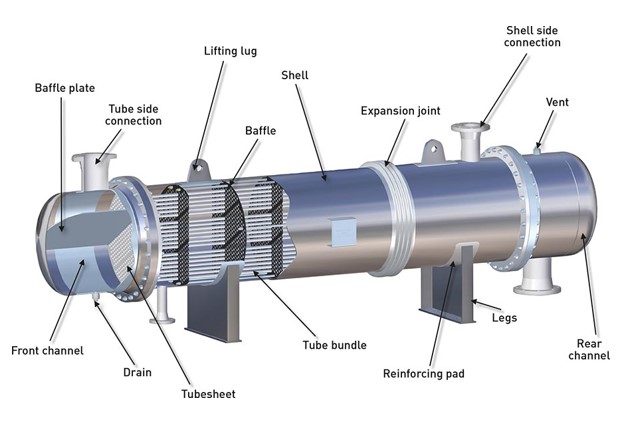The range of tubular heat exchangers is very wide. It begins with small stainless steel heat exchangers of a few dozen tubes for the food industry and doesn't even end with large exchangers such as steam generators in the nuclear industry, which can count over 10.000 tubes per plate.
What is a tubular heat exchanger? What are the pros and cons?
What types of applications are they used for?
We will provide you with answers for all these questions in this article!
How a Tubular Heat Exchanger Works
A tubular exchanger is a type of heat exchanger with tubes encompassed in a shell. It is a very common device in industries where the focus is recovering heat from gas or liquids.
The principle of the shell and tube heat exchanger is based on a bundle of tubes that is arranged vertically or horizontally inside a so-called shell.
It works by exchanging heat between two fluids. One is the "heating" and the other is the "heated" fluid.
The fluids can be of various natures and the tubular exchanger can be used for the exchange of gas/gas, liquid/liquid, liquid/gas, etc.
There are different categories of shell and tube heat exchangers on the market, each one designed for a specific application:
- Condenser: In this configuration, the purpose of the exchanger is to allow the transformation of a gas into a liquid. The role of the exchanger, as its name indicates, is to condense steam on a cold surface. The condenser is therefore a refrigeration system that allows a heat exchange between a refrigerant and an external medium, ensuring the change of state of the fluid at constant pressure and then its desuperheating as well as its sub-cooling. This way, the fluid leaves the condenser in a liquid state and no longer as a gas.
- Cooler: This time, the role of the exchanger is to cool a liquid.
- Boiler: The main purpose of this process is to partially vaporize the bottoms of the distillation columns. A mixture of liquids or a mixture of liquids and solids is vaporized. This process is also used for heating.
- Heater: Capable of operating in extreme conditions, the purpose of the heater in industries is to heat a volume of liquid or gases.
- Evaporator: Its purpose is to concentrate a solution thanks to a contribution of energy to carry out a change of state from the liquid phase to the gaseous phase.
- Crystallizer: In this last configuration, the exchanger will allow to isolate a product to retrieve it from a solution in a solid form.
Sizing a Shell and Tube Heat Exchanger
The first step in the sizing process is to choose the most suitable technology for the customer. This involves considering the role that the exchanger will play in the industry, its location, the type of fluids, the pressures, and the temperatures.
Once these dimensions are established, the thermal power of the shell and tube exchanger must be determined and the necessary heat exchange surface calculated.
As a next step, it is important to measure the tolerable pressure drop, i.e., the energy loss that a moving fluid undergoes.
Once the construction plans are ready, the tubular heat exchanger is then ready to be manufactured.
Tubular heat exchangers are made of stainless steel, Duplex, nickel alloy or Incoloy.
Pros and Cons of Tubular Heat Exchangers
First, the tubular exchanger is extremely robust and reliable. It is a piece of industrial equipment made of stainless steel, so it can withstand high pressures and extreme temperatures. This exchanger can operate with different types of fluids and can be adapted to different applications.
Although a tubular exchanger has many advantages, it is a bulky piece of equipment, which is why it is essential to think about the space it will occupy in the workshop. In fact, tubular exchangers can sometimes measure several tens of meters long.
Moreover, the risk of material deposits within the exchanger must be considered, as well as the fact that inspection is not easy. Many shell and tube exchangers are made up of large tubes that must be removed entirely from the device to clean them.
Some vocabulary:
 Source figure: thermofin.com
Source figure: thermofin.com
We are particularly interested in the connection between the tube bundle, i.e., each tube, and the tube plate. This connection can be of different natures.
In many cases, they are only rolled, which means that a machine is used to roll the tube onto the hole in the tube sheet. In some cases, where there is a need for high load resistance, the tubes are butt welded to the plate and then rolled in a second step.
Obviously we are particularly interested in the welded connection.
A broad choice of materials:
|
TUBES |
SHELL |
TUBE PLATE |
|
Steel Stainless steel (304, 316L, etc.) Brass Copper Nickel 90/10 Copper Nickel 70/30 Titanium Copper Monel Incoloy |
Steel Stainless steel (304, 316L, etc.) Aluminum Monel |
Steel Stainless steel (304, 316L, etc.) Naval brass Aluminum Copper Nickel 90/10 Copper Nickel 70/30 Titanium Monel |
We mainly focus on tubular exchangers made of stainless steel, titanium or other alloys because for steel exchangers, the TIG welding process is not always the most suitable.
Fields of Application for Tubular Exchangers
The so-called "shell and tube" heat exchangers are pieces of equipment adapted to all industrial sectors such as chemicals, petrochemicals, pharmaceuticals, food processing, sugar refineries, distilleries or energy.
As you can see, the world of tubular heat exchangers encompasses a wide spectrum. It is therefore vital to choose the right one according to the specific application and the technology best suited to the user.


